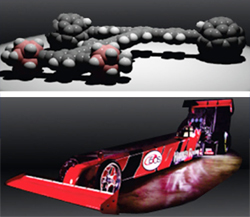Scientists from Texas, USA, report the preparation of a racing nanocar that could accelerate progress in the development of a new generation of futuristic molecular machines

Scientists from Texas, USA, report the preparation of a racing nanocar that could accelerate progress in the development of a new generation of futuristic molecular machines. The "vehicle" - with a thickness of 1/50000 of a human hair - resembles an ancient racing car in its shape and its performance is improved from that of other nano-vehicles prepared in the past. The findings were published in the scientific journal Organic Letters.
The researchers note that the ability to control the movement of small particles is essential for the successful preparation of molecular machines. Some of these machines will be able to be used in the future in the production of electrical circuits in computers and other electronic components. Scientists have already advanced the field in the past by preparing nano-vehicles, including a "nano-car" whose wheels are made up of buckyballs - a ball of sixty carbon atoms each. The "car" is able to move quickly over a gold surface when exposed to cascades of heat or an electric field. However, the control of its movements is limited and this shortcoming prevents the spread of the usefulness of this nanomachine. In addition to this, the most limiting factor is the collection of nanometer tools available for examining the multitude of movements and capabilities of these nanomachines.
The new vehicle solves some of these problems - its front end has a smaller axle and the wheels are made of special materials that move more easily. The rear wheels have a longer axle, but still consist of bucky balls, which have a strong surface grip. These changes led to the receipt of a "nano racing car" capable of operating at temperatures lower than those at which other nanocars operate and whose movement is faster, thus paving the way for the preparation of better molecular machines, the scientists claim.

2 תגובות
A nanomachine that can move on a silicon wafer and put all kinds of materials on it or take it off, instead of the current photolithography methods.
This sequel is very interesting.
The question is what is the ultimate goal? How are they supposed to be "integrated into the production of electrical circuits in computers and other electronic components" and why exactly integrate them there?